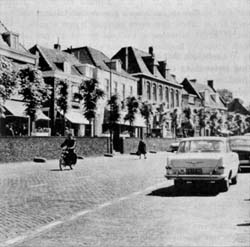
. . . this pattern helps complete the NETWORK OF PATHS AND CARS (52) and ROAD CROSSINGS (54). It is true that in most cases, pedestrian paths which follow the path network will be running across roads, not next to them. But still, from time to time, especially along major PARALLEL ROADS (23), between one road crossing and the next, there is a need for paths along the road. This pattern gives these special paths their character.

Where fast moving cars and pedestrians meet in cities, the cars overwhelm the pedestrians. The car is king, and people are made to feel small.
Therefore:
We conclude that any pedestrian path along a road carrying fast-moving cars should be about 18 inches above the road, with a low wall or railing, or balustrade along the edge, to mark the edge. Put the raised walk on only one side of the road - make it as wide as possible.


This cannot be solved by keeping pedestrians separate from cars; it is in their nature that they have to meet, at least occasionally - NETWORK OF PATHS AND CARS (52). What can be done at those points where cars and pedestrians do meet?
On an ordinary street, cars make pedestrians feel small and vulnerable because the sidewalks are too narrow and too low. When the sidewalk is too narrow, you feel you are going to fall off, or get pushed off - and there is always a chance that you will step off just in front of a passing car. When the sidewalk is too low, you feel that cars can easily mount the sidewalk, if they go out of control, and crush you. It is clear, then, that pedestrians will feel comfortable, powerful, safe, and free in their movements when the walks they walk on are both wide enough to keep the people away from the cars, and high enough to make it quite impossible for any car to drive up on them by accident.

What is the right height for a raised walk? Our experiments suggest that pedestrians begin to feel secure when they are about 18 inches above the cars. There are a number of possible reasons for this finding.
One possible reason. When the car is down low and the pedestrian world physically higher, pedestrians feel, symbolically, that they are more important than the cars and therefore feel secure.
Another possible reason. It may be that the car overwhelms the pedestrian because of a constant, unspoken possibility that a runaway car might at any moment mount the curb and run him down. A car can climb an ordinary six inch curb easily. For the pedestrian to feel certain that a car could not climb the curb, the curb height would have to be greater than the radius of a car tire (10 to 15 inches).
Another possible reason. Most people's eye level is between 51 and 63 inches. A typical car has an overall height Of 55 inches. Although tall people can see over cars, even for them, the cars fill the landscape since a standing person's normal line of sight is 10 degrees below the horizontal (Henry Dreyfus, The Measure of Man, New York, 1958, sheet F). To put a car 12 feet away completely below a pedestrian's line of sight, it would have to be on a road some 18 to 30 inches below the pedestrian.

